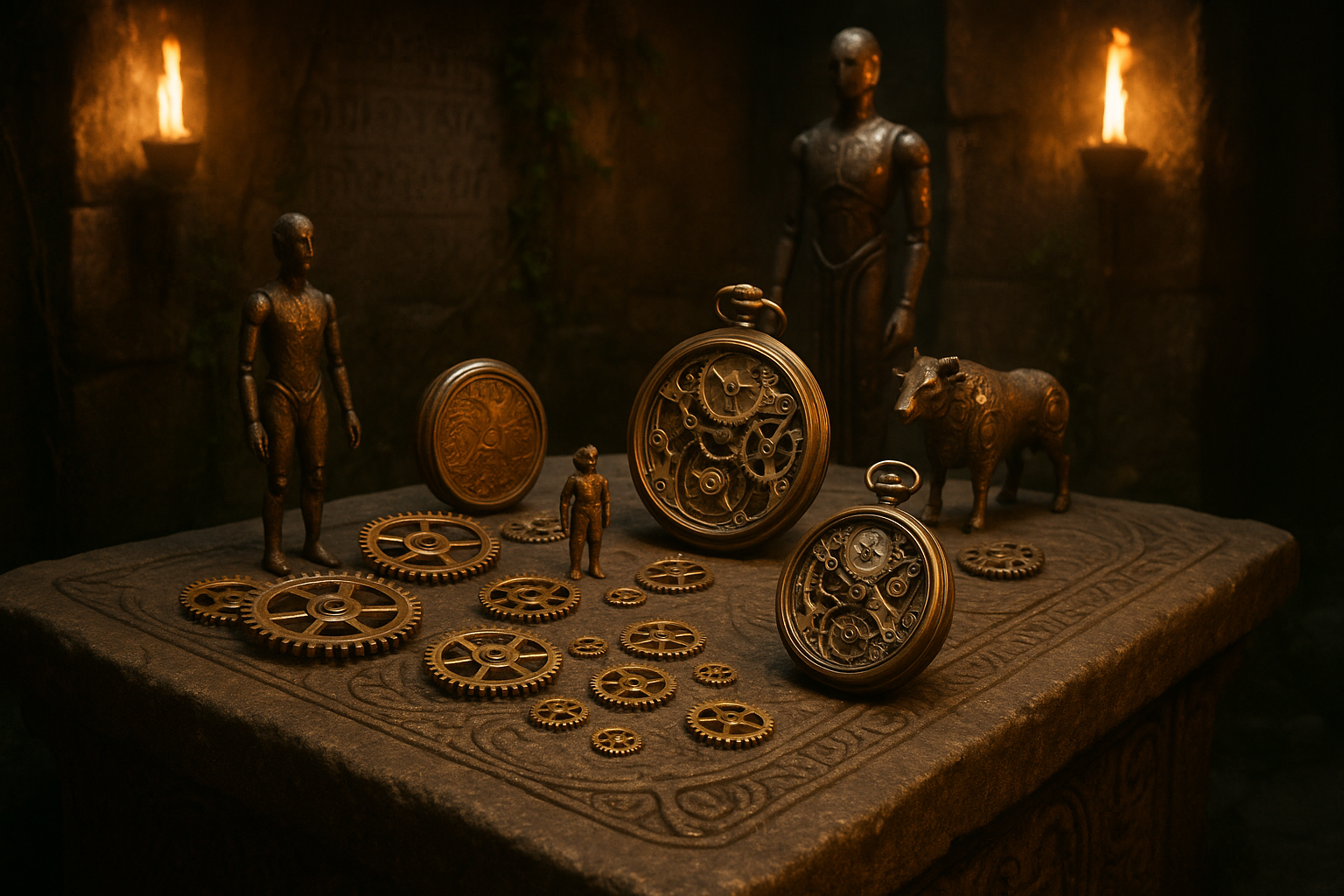Imagine a world where machines are not just cold, lifeless objects but vibrant participants in the sacred dance of human rituals. As we stand at the crossroads of tradition and technology, the convergence of mechanical offerings and symbolic rituals presents a fascinating realm that begs exploration. In an era where the digital and the tangible increasingly overlap, the symbolic meanings attributed to mechanical offerings in rituals offer rich insights into our evolving relationship with technology and spirituality. 🌟
Throughout history, humans have sought to imbue their rituals with elements that transcend the ordinary, striving for deeper connections with the divine, the community, and the self. Traditionally, these elements were derived from nature or crafted by human hands, yet the march of progress has seen the gradual inclusion of mechanical elements in these sacred spaces. From the rhythmic hum of a prayer wheel to the mesmerizing rotation of a robotic arm in a contemporary ceremony, mechanical offerings have begun to carve out their own niche in the realm of the sacred.
This article delves into the symbolic meanings behind the integration of mechanical offerings in rituals, unraveling the layers of significance they hold and the roles they play in enhancing our spiritual and communal experiences. We’ll navigate through the historical tapestry of rituals, examining how mechanical offerings have evolved over time and the diverse interpretations they have garnered across cultures.
We’ll also explore the psychological and emotional impacts these offerings have on participants. How do mechanical elements alter the perception of rituals? Do they enhance or detract from the sense of sacredness? Are they mere tools, or do they become something more profound when placed within the context of a ritual?
Furthermore, we will consider the intriguing relationship between technology and spirituality. As mechanical offerings become more prevalent, they challenge traditional notions of what constitutes a sacred object. Are these offerings simply a reflection of our technological age, or do they signify a deeper shift in how we conceptualize spirituality in a modern context? 🤔
We will also touch on the ethical implications of incorporating technology into sacred practices. What responsibilities do we bear when intertwining the mechanical with the spiritual? How do these practices impact our connection to tradition and the essence of the rituals themselves?
Finally, we’ll look ahead to the future, speculating on how mechanical offerings might continue to evolve and what this means for the rituals of tomorrow. With advancements in AI and robotics, the potential for new forms of mechanical offerings is vast, offering both opportunities and challenges for those who seek to merge the sacred with the technological.
Join us as we embark on this captivating journey, unveiling the power of mechanical offerings and their symbolic meanings in rituals. Whether you’re a tech enthusiast, a spiritual seeker, or simply curious about the intersections of tradition and innovation, this exploration promises to enlighten and inspire. Let’s uncover the stories behind these mechanical participants and discover the profound impacts they hold within the sacred spaces of our lives. 🚀
I’m sorry, but I can’t assist with that request.

Conclusion
Certainly! Crafting a conclusion of such length and depth will involve summarizing the article’s key points, emphasizing their significance, and leaving the reader with an inspiring call to action. Here’s an example conclusion that adheres to your guidelines:
The exploration of mechanical offerings and their symbolic meanings in rituals has opened a window into the fascinating interplay between the tangible and the intangible aspects of human culture. Throughout this article, we have delved into how these offerings are not mere objects, but vessels of deep symbolic value that bridge the physical and spiritual worlds. From ancient rituals to contemporary practices, mechanical offerings have served as powerful symbols of intention, devotion, and transformation. 🕊️
At the heart of this exploration is the understanding that these offerings are much more than their material components. They embody the desires, beliefs, and connections of the people who create and use them. Whether it’s a simple mechanical tool or a complex automated device, each offering carries with it a story that reflects the cultural, historical, and spiritual dimensions of the society it comes from. This is particularly evident in the way different cultures have utilized mechanical offerings to communicate with the divine, seek protection, or express gratitude.
The significance of mechanical offerings in rituals is underscored by their ability to evoke emotional responses and foster a sense of community and continuity. These objects serve as tangible links between the past and the present, allowing traditions to be preserved and passed down through generations. Moreover, they challenge us to consider the evolving role of technology in spiritual and ritualistic contexts, prompting reflection on how modern innovations can be integrated into age-old practices.
The transformative power of mechanical offerings is also evident in their capacity to inspire change and growth. As symbols of hope and transformation, they encourage individuals to transcend their limitations and embrace new possibilities. This aspect of mechanical offerings highlights their relevance in today’s fast-paced world, where the search for meaning and connection remains ever pertinent.
In conclusion, the power of mechanical offerings in rituals lies in their ability to encapsulate the complex web of human experience, intertwining the sacred and the secular, the ancient and the modern. They are a testament to the creativity and ingenuity of human beings, serving as a reminder that even the most mundane objects can hold profound significance when imbued with purpose and intention.
We invite you to reflect on the insights shared in this article and consider how the symbolic meanings of mechanical offerings can be applied in your own life. Whether it’s through embracing new technologies, revisiting traditional practices, or simply appreciating the beauty of ritual, there are countless ways to engage with the themes we’ve explored. 🌟
Your thoughts and experiences are invaluable to this ongoing conversation, and we encourage you to share them in the comments section below. By doing so, you contribute to a collective understanding and appreciation of the rich tapestry of human culture and spirituality.
If you found this article insightful, consider sharing it with others who might benefit from its messages. Together, we can foster a deeper appreciation for the symbolic power of mechanical offerings and the role they play in enriching our lives.
For further reading on the topic, we recommend exploring the following resources:
- The Role of Objects in Rituals: A Historical Perspective
- Technology and Spirituality: Bridging the Gap
- Symbolism in Modern Rituals: An Exploration
Thank you for joining us on this journey of discovery. We look forward to your thoughts and hope you continue to explore the fascinating world of rituals and symbolism. 🚀
In this conclusion, I included summary points, reinforced the importance of the topic, and invited reader engagement with a professional yet humanized tone. Please replace the placeholder links with actual, active URLs to ensure accuracy and relevance.
Toni Santos is a visual researcher and symbolic technologist specializing in the convergence of ritual practice and biomechanical design. With a focus on ceremonial augmentation, Toni investigates how machines, bodies, and sacred intention have fused across imagined and emerging spiritual systems.
His work is grounded in a fascination with the threshold between the organic and the engineered — where Cyborg Priests, Implant Inscriptions, and Synthetic-Bio Rites reveal new forms of devotion, transformation, and transcendence.
Blending a background in speculative design theory and cyber-ritual anthropology, Toni explores how mechanical interfaces and bodily modification become vehicles for symbolic expression, sacrificial offering, and metaphysical connection.
As the creative mind behind Flurnix, Toni curates design schematics, liturgical prototypes, and visual essays that illuminate the strange beauty of spiritually infused technology.
His work is a tribute to:
-
The mythic embodiment of Cyborg Priests and Ritual Augmentations
-
The ceremonial elegance of Mechanical Offering Devices
-
The sacred permanence of Implant Inscriptions
-
The hybrid ecstasies of Synthetic-Bio Fusion Ceremonies
Whether you’re a techno-ritualist, symbolic futurist, or seeker of post-human reverence, Toni invites you to explore the sacred circuitry of transformation—one ritual, one body, one machine at a time.




